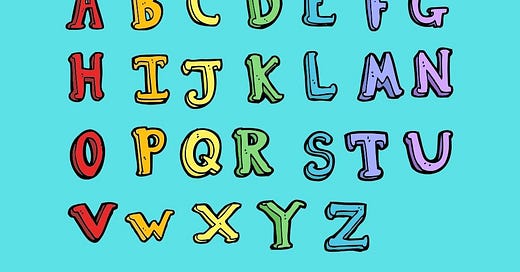Hello music-loving friend,
There’s a pretty good chance you can sing the Alphabet Song, no matter the country in which you grew up. It’s etched onto my brain (along with the music from various television commercials and after-school sitcoms; The Brady Bunch or Happy Days anyone?).
A, B, C, D, E, F, G
H, I, J, K, L, M, N, O, P
Q, R, S, T, U, V
W, X, Y, Z
Now I know my ABCs
Next time, won't you sing with me?
There is one tiny bit of controversy attached to the ABC song, which has to do with whether or not you pronounce the Z as Zed (as in bed) or Zee (as in bee). As a good little Aussie, I’m firmly in the Zed camp, even though it doesn’t rhyme at all!
The melody dates from 1761, and was already snatched up for Twinkle Twinkle Little Star and Baa Baa Black Sheep, among other children’s songs, and before that you can hear it used in Mozart’s Twelve Variations.
The version we know and love came into being around 1835. Here’s a beautiful 1971 version of the song from Sesame Street ( listen for the Zee!), with animation from Paul Fierlinger:
The ABC Song is a great example of a musical mnemonic. A Mnemonic is a memory aid that helps improve your recall by grouping bits of information together in patterns. It might take the form of a rhyme or an acronym or a list.
What’s important is the way the information is grouped together, which really helps us to remember stuff. My favourite example of an acronym-style mnemonic is ROYGBIV: Red, Orange, Yellow, Green, Blue, Indigo, Violet, the hues of the colour spectrum—or you can think of them as the colours of the rainbow—and which is stuck in my memory for ever more.
A musical mnemonic…wait for it…combines all this with music. There’s a long history throughout the world of music being used as a way to pass on oral history, and this is because it works so well for remembering anything, from history, languages, and dates, through to multiplication tables or anything else you can think of.
Our brains are naturally wired to remember rhythms and melodies (check out last week’s post on Earworms for more). And the simple fact is that listening to a mnemonic song reinforces information in our brains, making it much easier to recall. You can also make up your own. Either create a tune or steal one that’s been used before (I’m looking at you, Mozart), and off you go.
You can reinforce the process even further by coming up with some movements to go with it. A great example of this is the children’s song Head, Shoulders, Knees, and Toes, in which kids—hopefully—tap the relevant body part as they sing.
I’m going to leave you with a very cool example of a musical mnemonic, called The Elements, written by the mathematician and musician Tom Lehrer in 1959. He incorporated all the known chemical elements (at the time), into this fast-paced song. If you’re familiar with the periodic table, you’ll notice that they’re not always in order because he’s used a bit of musical licence to reorder them to fit in with how he wanted the song to sound.
Now, excuse me while I go and make up my own musical mnemonic to help me remember my German grammar…uf Widerluege!
Thank you for taking the time to read my post. If there's anything else you're curious about or would like me to explore further, please let me know.
You can comment on this post or send me a message at katepainediscoveringmusic@substack.com
And while you’re at it, why not become a subscriber?
Thanks, Kate ❤️




